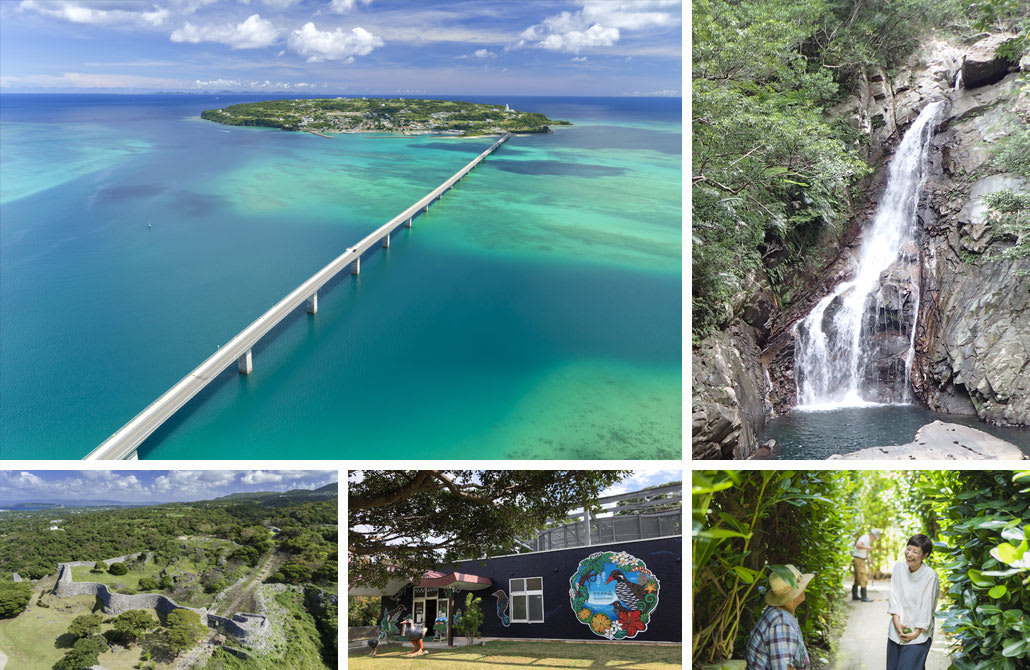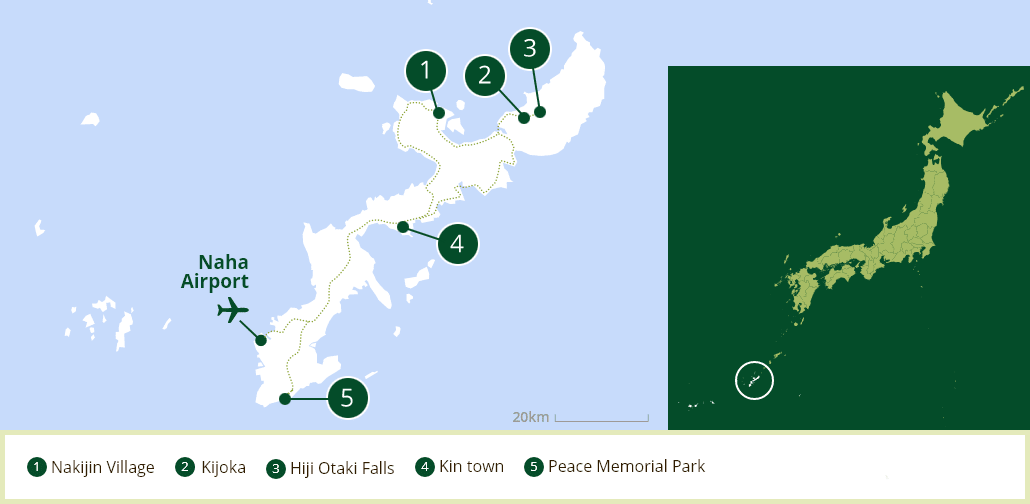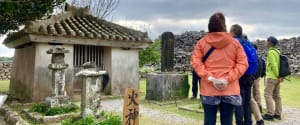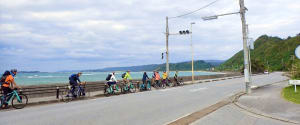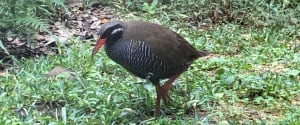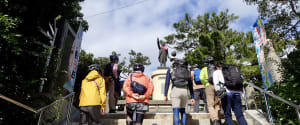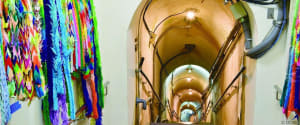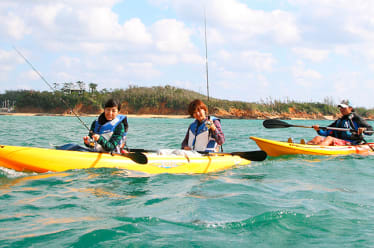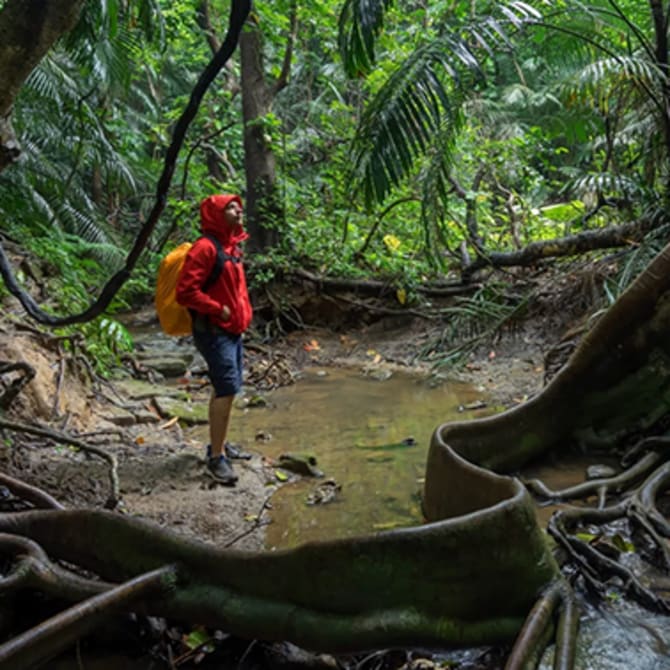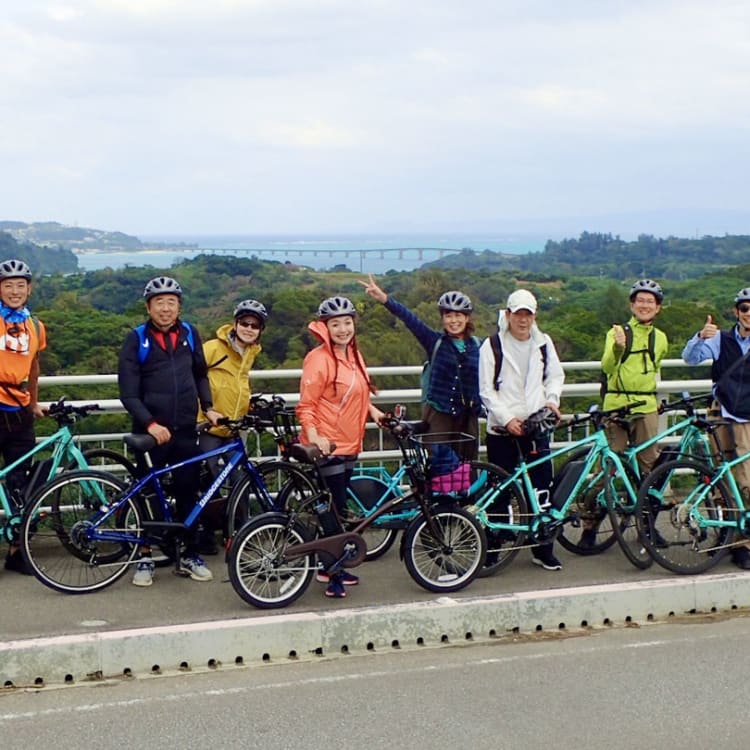
Recommended Route Okinawa (Main Island)
Day 1
Encounters with Okinawan Food and Culture
When you arrive at Motobu port, you will move to Nakijin Village where you will be given an overview of the course and today’s itinerary at Cafe Kokuu. A welcome ceremony with sanshin (Okinawan traditional instrument), singing, and performance will be held for you to experience the culture.
Lunch :
After the ceremony, the restaurant will serve vegetarian and macrobiotic plates free of sugar, dairy products, ane meat, using as many pesticide-free vegetables as possible. You may fully enjoy the locally grown seasonal island vegetables that are brought in each morning. Experience with your tongue and stomach Okinawa's reputation as an island of longevity that belongs to the Blue Zone.
Guided Tour of Castle Ruins & Villages :
In the village of Imadomari, located at the foot of the ruins of Nakijin Castle, learn about the lives of the people at the residence of Noro, a female priestess in the Ryukyu Shinto religion, and other places of interest and residences related to the castle ruins. Don't miss the rows of fukugi trees and bamboo rail fence.
After that, we will take the hanta-michi (mountain path) leading to the ruins of Nakijin Castle, which is said to be the oldest castle before the establishment of the Ryukyu Kingdom. You will learn about the relationship between Utaki (sacred site) and Gusuku (fortress) while also experiencing the spiritual culture of Okinawa . The spectacular view of the village, the reef, the open sea, Izena Island, and Iheya Island can be seen from the high vantage point, and you can almost imagine what King Hokuzan, who ruled this region around 1322, saw during his reign there.
Dinner :
Dinner will take place at Nagato-ya. It is said that the Kume 36 family members who came to Okinawa from China around the 14th century brought the cooking method along with pigs, and pigs have developed as food for hospitality for the Register of envoys and as court food for the Ryukyu Dynasty. It is said that it was the introduction of potatoes in 1605 that dramatically developed pig farming, explaining the historical and cultural importance of pigs in Okinawa .
Among Okinawa's high-quality native breeds, Nakijin Agu is dedicated to native pigs (Ryukyuan native black pigs), which sets it apart from other pigs.
Shabu-shabu is served with locally grown island vegetables. Also available is Nakijin Brewery’s Awamori Uruwashiki Furusato 30°, which won the Platinum Award, the highest gold medal, at the Kuramaster Authentic Shochu and Awamori Competition, a sake competition held in France for French people.
Lunch :
After the ceremony, the restaurant will serve vegetarian and macrobiotic plates free of sugar, dairy products, ane meat, using as many pesticide-free vegetables as possible. You may fully enjoy the locally grown seasonal island vegetables that are brought in each morning. Experience with your tongue and stomach Okinawa's reputation as an island of longevity that belongs to the Blue Zone.
Guided Tour of Castle Ruins & Villages :
In the village of Imadomari, located at the foot of the ruins of Nakijin Castle, learn about the lives of the people at the residence of Noro, a female priestess in the Ryukyu Shinto religion, and other places of interest and residences related to the castle ruins. Don't miss the rows of fukugi trees and bamboo rail fence.
After that, we will take the hanta-michi (mountain path) leading to the ruins of Nakijin Castle, which is said to be the oldest castle before the establishment of the Ryukyu Kingdom. You will learn about the relationship between Utaki (sacred site) and Gusuku (fortress) while also experiencing the spiritual culture of Okinawa . The spectacular view of the village, the reef, the open sea, Izena Island, and Iheya Island can be seen from the high vantage point, and you can almost imagine what King Hokuzan, who ruled this region around 1322, saw during his reign there.
Dinner :
Dinner will take place at Nagato-ya. It is said that the Kume 36 family members who came to Okinawa from China around the 14th century brought the cooking method along with pigs, and pigs have developed as food for hospitality for the Register of envoys and as court food for the Ryukyu Dynasty. It is said that it was the introduction of potatoes in 1605 that dramatically developed pig farming, explaining the historical and cultural importance of pigs in Okinawa .
Among Okinawa's high-quality native breeds, Nakijin Agu is dedicated to native pigs (Ryukyuan native black pigs), which sets it apart from other pigs.
Shabu-shabu is served with locally grown island vegetables. Also available is Nakijin Brewery’s Awamori Uruwashiki Furusato 30°, which won the Platinum Award, the highest gold medal, at the Kuramaster Authentic Shochu and Awamori Competition, a sake competition held in France for French people.
Day 2
The Roots of Our Culture and Traditions
Cycle and cross the 1,960-meter-long bridge connecting Kouri ( Kouri Island ) in Nakijin Village and Sumuide (Yagaji Island) in Nago City. After the 22-kilometer cycle and the sense of accomplishment of conquering the heart-breaking hill, hand-pick the in-season shekwasha and recover from fatigue with juice squeezed on the spot, with a method utilizing toothpicks used by locals.
Lunch :
Margarita pizza baked by yourself in a stone oven set up outdoors, topped with plenty of fuchiba (mugwort). The fresh mugwort goes perfectly with the cheese.
The restaurant's name, Gajimanro, is an auspicious word in the Okinawa n dialect meaning "richly fruitful fields," and it is a wish that crops will grow well and that many people will gather there. From the spacious terrace seats, you can enjoy a panoramic view of Bojimui forest and Kuwadakimui forest, the symbols of Ogimi Village. You can spend your time lying down in a hammock for a nap or enjoy a swing ride with a very good view from the hill.
Walking through the Unchanged Scenery of Yanbaru Village :
Visitors will stroll through the streets of the Kijoka community, which can be called the original landscape of Yanbaru. Here you can experience the lifestyle of Yanbaru with its mountains, forests, rivers, and ocean. The Kijoka community had many ship carpenters, who eventually moved to Naha as excellent carpenters. For this reason, the women of the village were engaged in the production of bashofu, a type of cloth made from the fibers of the itabasho plant. Bashofu is a specialty of Okinawa Prefecture and the Amami Islands , and is used heavily in the hot and humid areas where people sweat easily because of its thin, lightweight texture.
Dinner :
Dinner will be at a restaurant directly managed by a fishing cooperative which has a significant economic impact on the local community. The subtropical fish served here are appreciated for their rich, fresh flavor.
Lunch :
Margarita pizza baked by yourself in a stone oven set up outdoors, topped with plenty of fuchiba (mugwort). The fresh mugwort goes perfectly with the cheese.
The restaurant's name, Gajimanro, is an auspicious word in the Okinawa n dialect meaning "richly fruitful fields," and it is a wish that crops will grow well and that many people will gather there. From the spacious terrace seats, you can enjoy a panoramic view of Bojimui forest and Kuwadakimui forest, the symbols of Ogimi Village. You can spend your time lying down in a hammock for a nap or enjoy a swing ride with a very good view from the hill.
Walking through the Unchanged Scenery of Yanbaru Village :
Visitors will stroll through the streets of the Kijoka community, which can be called the original landscape of Yanbaru. Here you can experience the lifestyle of Yanbaru with its mountains, forests, rivers, and ocean. The Kijoka community had many ship carpenters, who eventually moved to Naha as excellent carpenters. For this reason, the women of the village were engaged in the production of bashofu, a type of cloth made from the fibers of the itabasho plant. Bashofu is a specialty of Okinawa Prefecture and the Amami Islands , and is used heavily in the hot and humid areas where people sweat easily because of its thin, lightweight texture.
Dinner :
Dinner will be at a restaurant directly managed by a fishing cooperative which has a significant economic impact on the local community. The subtropical fish served here are appreciated for their rich, fresh flavor.
Day 3
The Heart of Our Nature and Traditional Culinary Soul
Start your day off with a refreshing morning dip in the calm, blue sea. The blue sky reflected in the water is one of the most stunning sights you will ever witness.
Breakfast :
Visitors can experience local home cooking using papaya, gurukun (double-lined fusilier), and other locally produced and consumed ingredients that can only be found here. Visitors can also taste delicious rice cooked the old-fashioned way, using a restored cooking stove and firewood, which is no longer seen in modern times.
After breakfast, let's dive into Yanbaru's conservation history, nature and biodiversity. Learn about the World Natural Heritage efforts to protect the Yanbaru kuina (Okinawa rail), which were realized through the concerted efforts of local residents, including the establishment of the nation's first microchip registration ordinance for cats, and volunteer efforts by local residents to raise earthworms for food and erect protective fences.
Lunch :
You can taste the longevity food of Ogimi Village, which was featured in the best-selling book "Ikigai" in Europe. No pesticides or chemical fertilizers are used. In addition to being safe, the restaurant only uses seasonal vegetables to serve traditional dishes.
Encounters with the Endemic Creatures of Yanbaru :
Learn about the world-class biodiversity that is central to Yanbaru and enjoy the charm of the forest. Hiji-Otaki Waterfall. The 40-minute walk to the waterfall, which boasts a drop of 25.7 meters, is a well-maintained promenade that allows visitors to enjoy the Yanbaru Forest, a UNESCO Natural World Heritage Site, while walking at a leisurely pace. The trail offers many encounters and discoveries with the endemic creatures that are the charm of the Yanbaru forests.
Dinner :
Enjoy a Haikei BBQ in the grounds of the old house hotel. Using haikei, which are chickens that have stopped giving eggs, is a part of Yanbaru's culinary tradition. Although they are known for their tough meat, local Haikei Meisters can prepare and cook them in a nice, delightful style. In addition to this, you can also enjoy a set of fish and fresh meat from the local farm and enjoy the Okinawan culture that is still passed down today, with locals, lively songs, sanshin, and other traditional music.
Breakfast :
Visitors can experience local home cooking using papaya, gurukun (double-lined fusilier), and other locally produced and consumed ingredients that can only be found here. Visitors can also taste delicious rice cooked the old-fashioned way, using a restored cooking stove and firewood, which is no longer seen in modern times.
After breakfast, let's dive into Yanbaru's conservation history, nature and biodiversity. Learn about the World Natural Heritage efforts to protect the Yanbaru kuina (Okinawa rail), which were realized through the concerted efforts of local residents, including the establishment of the nation's first microchip registration ordinance for cats, and volunteer efforts by local residents to raise earthworms for food and erect protective fences.
Lunch :
You can taste the longevity food of Ogimi Village, which was featured in the best-selling book "Ikigai" in Europe. No pesticides or chemical fertilizers are used. In addition to being safe, the restaurant only uses seasonal vegetables to serve traditional dishes.
Encounters with the Endemic Creatures of Yanbaru :
Learn about the world-class biodiversity that is central to Yanbaru and enjoy the charm of the forest. Hiji-Otaki Waterfall. The 40-minute walk to the waterfall, which boasts a drop of 25.7 meters, is a well-maintained promenade that allows visitors to enjoy the Yanbaru Forest, a UNESCO Natural World Heritage Site, while walking at a leisurely pace. The trail offers many encounters and discoveries with the endemic creatures that are the charm of the Yanbaru forests.
Dinner :
Enjoy a Haikei BBQ in the grounds of the old house hotel. Using haikei, which are chickens that have stopped giving eggs, is a part of Yanbaru's culinary tradition. Although they are known for their tough meat, local Haikei Meisters can prepare and cook them in a nice, delightful style. In addition to this, you can also enjoy a set of fish and fresh meat from the local farm and enjoy the Okinawan culture that is still passed down today, with locals, lively songs, sanshin, and other traditional music.
Day 4
Discover the Ways Okinawa Embraced Cultural Diversity
For breakfast, have a refreshing frozen smoothie made with delicious prefectural produce. Along with a bagel, you can select from two smoothie varieties: bitter melon and passion fruit. After a heavy day of eating, your stomach will appreciate a revitalizing breakfast like this.
After breakfast, depart from Nammeishinshitsu and board a microbus to go to Kin town. Walk around the Camp Hansen area in front of the base in Kin Town, which coexists with the base. The tour will not only present the Japanese and Okinawan perspectives, but also the roles played in World War II, the postwar Cold War, the Korean War, and the Vietnam War, as well as the issues of Futenma, Henoko, etc., from various perspectives.
Lunch :
After that, you will eat lunch on the terrace at Sunrise Beach. Here you can try chiricha, a stew-like dish made with pork and pig blood. The dish was influenced by feijoada brought back from Brazil by South American immigrants and developed in Kin Town. There are also Okinawan soba and vegetarian options available for those who prefer something different. While you are in this area, the tour guide will teach you about the area's diversity of wild birds, high-quality agricultural products such as taro, and how Okinawans coexist with American forces.
After eating, you will be getting a little exercise by Cycling around. You will then visit the Ryukyu Awamori Brewery Matsufuji, which won a gold medal at a sake competition in Paris. Discover the origins of Awamori and try some yourself.
Dinner :
Visit the bars in Kin Town's Shinkaichi, which has a distinct culture blending Okinawan and American worldviews. You can also try the area’s famous taco rice, which is another product of the merging of cultures. There are also vegetarian choices that include vegetables and island tofu.
After breakfast, depart from Nammeishinshitsu and board a microbus to go to Kin town. Walk around the Camp Hansen area in front of the base in Kin Town, which coexists with the base. The tour will not only present the Japanese and Okinawan perspectives, but also the roles played in World War II, the postwar Cold War, the Korean War, and the Vietnam War, as well as the issues of Futenma, Henoko, etc., from various perspectives.
Lunch :
After that, you will eat lunch on the terrace at Sunrise Beach. Here you can try chiricha, a stew-like dish made with pork and pig blood. The dish was influenced by feijoada brought back from Brazil by South American immigrants and developed in Kin Town. There are also Okinawan soba and vegetarian options available for those who prefer something different. While you are in this area, the tour guide will teach you about the area's diversity of wild birds, high-quality agricultural products such as taro, and how Okinawans coexist with American forces.
After eating, you will be getting a little exercise by Cycling around. You will then visit the Ryukyu Awamori Brewery Matsufuji, which won a gold medal at a sake competition in Paris. Discover the origins of Awamori and try some yourself.
Dinner :
Visit the bars in Kin Town's Shinkaichi, which has a distinct culture blending Okinawan and American worldviews. You can also try the area’s famous taco rice, which is another product of the merging of cultures. There are also vegetarian choices that include vegetables and island tofu.
Day 5
Understanding the tragic history of Okinawa
This is the last morning of waking up in our tranquil island wonderland. Pack up and fill our bellies with a hearty breakfast.
Peace Memorial Park :
The Peace Memorial Park is located on a plateau overlooking the hills of Mabuni , Itoman City, the southern part of the main island of Okinawa . This rugged and beautiful coastline to the southeast is where the Battle of Okinawa ended. At the Cornerstone of Peace, visitors can gain an insight into the history of Okinawa with the U.S., U.K., Australia, Canada, and other allied nations. Although the subject discussed will be heavy, you will gain a thorough understanding of Okinawa , including its negative history and the tragedies of war from the perspectives of both Japan and the Allies. Learn about the Battle of Okinawa at the end of the Pacific War, where one in every four Okinawans died, and over 200,000 people were killed during the ferocious ground attacks, to rediscover the preciousness of peace.
Lunch :
You will then have lunch at the Himeyuri Restaurant. You can choose from the selection of typical Okinawan dishes such as soki soba (pork lib and buckwheat noodles), goya chanpuru (bitter melon stir-fry), as well as vegetarian meals.
The Former Japanese Navy Underground Headquarters:
This tunnel complex was dug in 1944 by 3000 men of the Japanese Navy Corps of Engineers as an underground headquarters. Located on a hill 74 meters above sea level, you can overlook the airport and harbor. At 20 meters deep and 450 meters long, this underground bunker was ruggedly constructed with concrete and pit stanchions to withstand heavy U.S. artillery fire and allow for long-term combat. It accommodated 4000 soldiers. After the war, the site remained untouched for some time. However, after multiple recoveries of the soldier's remains, In March 1970, the 300-meter section around the command room was restored and opened to the public. By visiting this site, you will gain a better understanding of the soldiers' lives during the war and how they endured bombardments from the American forces.
Your trip has now come to an end. Say your farewells to the beautiful island at Naha Airport and reflect on the remarkable history and nature of Okinawa on your travel home.
Peace Memorial Park :
The Peace Memorial Park is located on a plateau overlooking the hills of Mabuni , Itoman City, the southern part of the main island of Okinawa . This rugged and beautiful coastline to the southeast is where the Battle of Okinawa ended. At the Cornerstone of Peace, visitors can gain an insight into the history of Okinawa with the U.S., U.K., Australia, Canada, and other allied nations. Although the subject discussed will be heavy, you will gain a thorough understanding of Okinawa , including its negative history and the tragedies of war from the perspectives of both Japan and the Allies. Learn about the Battle of Okinawa at the end of the Pacific War, where one in every four Okinawans died, and over 200,000 people were killed during the ferocious ground attacks, to rediscover the preciousness of peace.
Lunch :
You will then have lunch at the Himeyuri Restaurant. You can choose from the selection of typical Okinawan dishes such as soki soba (pork lib and buckwheat noodles), goya chanpuru (bitter melon stir-fry), as well as vegetarian meals.
The Former Japanese Navy Underground Headquarters:
This tunnel complex was dug in 1944 by 3000 men of the Japanese Navy Corps of Engineers as an underground headquarters. Located on a hill 74 meters above sea level, you can overlook the airport and harbor. At 20 meters deep and 450 meters long, this underground bunker was ruggedly constructed with concrete and pit stanchions to withstand heavy U.S. artillery fire and allow for long-term combat. It accommodated 4000 soldiers. After the war, the site remained untouched for some time. However, after multiple recoveries of the soldier's remains, In March 1970, the 300-meter section around the command room was restored and opened to the public. By visiting this site, you will gain a better understanding of the soldiers' lives during the war and how they endured bombardments from the American forces.
Your trip has now come to an end. Say your farewells to the beautiful island at Naha Airport and reflect on the remarkable history and nature of Okinawa on your travel home.




















































